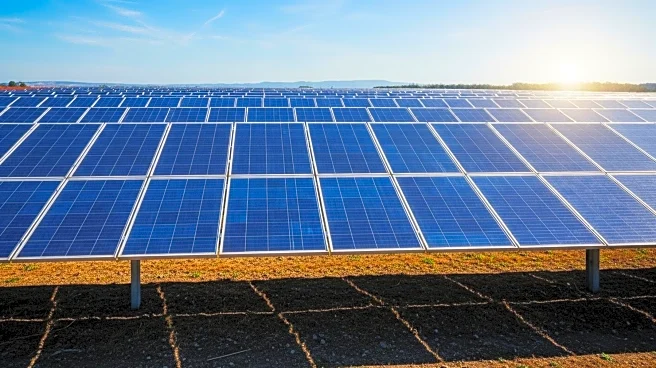What's Happening?
Manufacturers across the U.S. are increasingly adopting solar energy to align with environmental, social, and governance (ESG) goals. Companies like First Solar Inc. are leading the charge by integrating solar panels into their facilities, such as shaded carports that generate electricity for operations. This move not only reduces carbon footprints but also enhances energy independence and resilience. The U.S. solar capacity reached 139 gigawatts by the end of 2023, marking a 23% increase from the previous year. Utility-scale solar now accounts for about 8% of the nation's total electricity capacity, a significant rise from 1% in 2014. The shift towards renewable energy sources like solar and wind is expected to continue, reducing reliance on fossil fuels.
Why It's Important?
The adoption of solar energy by manufacturers is crucial for the clean-energy transition, supporting global sustainability goals. It offers significant business benefits, including reduced operational costs and enhanced energy security. Companies can achieve net-zero emissions more efficiently by leveraging digital tools for energy monitoring. This trend is also driven by increasing expectations from customers for sustainable supply chains. As more manufacturers become energy producers, they contribute to a sustainable energy system, potentially influencing broader industry practices and policies.
What's Next?
Manufacturers are expected to continue expanding their use of solar energy, with many setting ambitious targets for renewable energy usage. Companies like First Solar aim to power 100% of their U.S. operations with renewable energy by 2026. The trend may lead to more partnerships and power purchase agreements (PPAs) to secure stable, long-term renewable energy supplies. As state-level ESG regulations gain momentum, manufacturers may face new compliance requirements, necessitating strategic planning and data management to meet sustainability targets.
Beyond the Headlines
The shift to solar energy in manufacturing highlights broader implications for the industry, including potential changes in energy policy and market dynamics. It underscores the role of manufacturers in driving the clean-energy transition and the importance of integrating sustainability into business strategies. The move also reflects a growing recognition of the economic opportunities associated with renewable energy, which could lead to increased investment and innovation in the sector.











